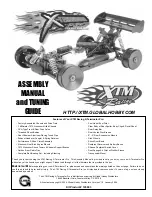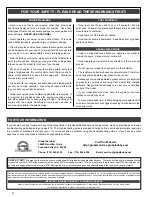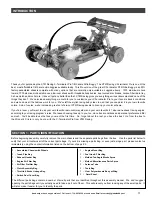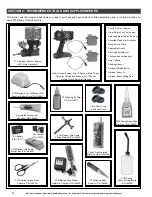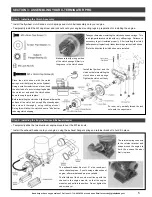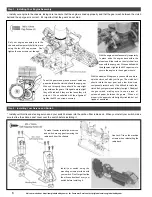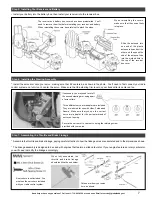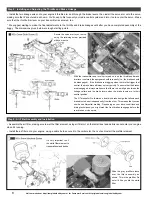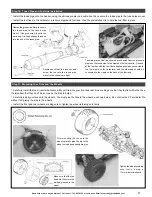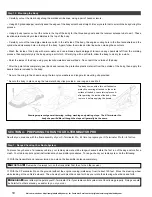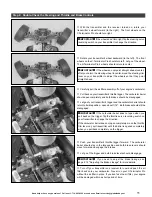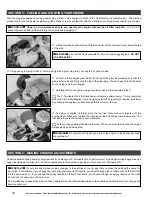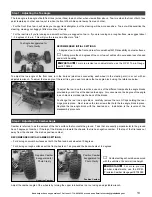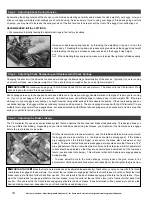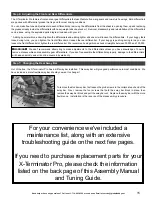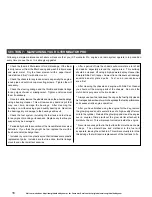
14
Visit our website at http://xtm.globalhobby.com or for Customer Service at http://globalservices.globalhobby.com
By adjusting the spring tension of the shocks, you can increase steering sensitivity and increase the ride-height of your buggy. How you
drive your buggy will dictate what settings you should be using. As an example, if you're using your buggy off-road and going over lots
of jumps, you may want to increase the spring tension of the front shocks to help prevent the front of the buggy from bottoming out.
RECOMMENDED INITIAL SETTINGS:
●
We recommend initially leaving the adjustment rings in the factory locations.
Step 3: Adjusting Shock Spring Tension
Increase or decrease spring tension by threading the adjustment ring up or down the
shock body. Threading the ring down increases spring tension and the buggy's ride height
and threading the ring up decreases spring tension and the buggy's ride height.
☞
When adjusting the spring tension, make sure to adjust the right and left sides equally.
Changing the shock oil (the oil inside the shocks) will change the dampening characteristics of the shocks. Typically, if you are running
on smooth surfaces, use a heavier weight oil. If you are running on rough surfaces, use a lighter weight oil.
✦
✦
✦
✦
✦
IMPORTANT
✦
✦
✦
✦
✦
We recommend using only 100% Silicone Shock Oil. Do not use motor oil. The shock oil in the X-Terminator Pro's
shocks is good for most off-road applications.
Shock springs are easy to change and can make a difference in the way your buggy handles relative to the type of terrain you're running
on. If you run your buggy off-road, in a smooth, high-traction area, use stiffer springs to reduce body roll and weight shift. If the area
where you run your buggy is very bumpy, you might consider using softer springs to help absorb the bumps. If the area is bumpy and you
use harder springs, the buggy will have a tendency to jump and hop around. The shock springs included with the X-Terminator Pro are
suitable for most general off-road applications, but experimentation with different shock springs may be necessary to find a setup that
suits your particular driving style and location.
Step 4: Adjusting Shock Dampening and Replacement Shock Springs
With the transmitter and receiver turned on, and the throttle and brake trim lever centered,
the buggy should roll smoothly (i.e., the brakes should be disengaged). If the brakes
are dragging when the throttle trigger is at neutral, the brake discs will wear out very
quickly. To ensure that the brakes are disengaged, always make sure that there is a 1/16"
wide gap between the two rear adjustment collars and the brake levers. Both adjustment
collars should be adjusted so that they are equal distance behind each of the two brake
levers (see important note below). This will ensure that both brake levers engage equally
during braking.
●
To make adjustments to the brake linkage, simply loosen the grub screw in the
adjustment collar behind each brake lever and reposition it, then retighten the grub screw.
The X-Terminator Pro uses a dual-disc brake system that can operate the front and rear brakes independently. This design allows you
to set up differential braking. Depending on your track conditions and driving techniques, you might want the front brakes to engage
before the rear brakes or vice-versa.
Step 5: Adjusting the Brake Linkage
✦
✦
✦
✦
✦
IMPORTANT NOTE
✦
✦
✦
✦
✦
Since the front and rear brakes can be adjusted independently of each other, you may not want both front and
rear brakes to engage at the same time. If you want the rear brakes to engage just before the front brakes, move the collar at the front
brake lever just a fraction further back from neutral. This will result in the back brakes engaging just before the front brakes. If you
want the front brakes to engage just before the rear brakes, move the collar at the rear brake lever just a fraction further back from
neutral. This will result in the front brakes engaging just before the back brakes. Experimentation will be necessary to achieve the
desired braking response, dependant on your track conditions and driving style.

